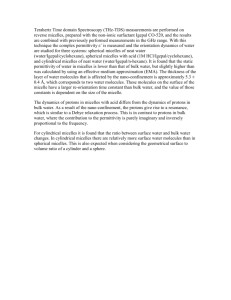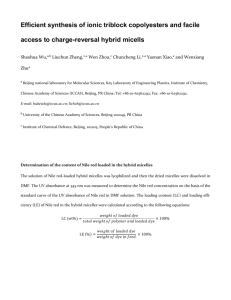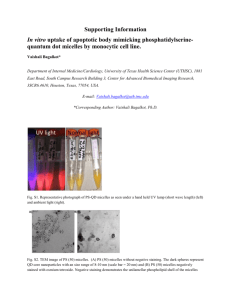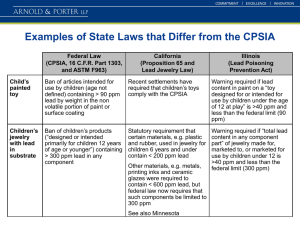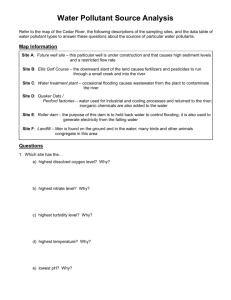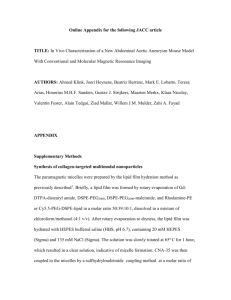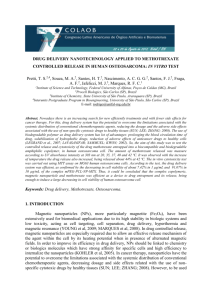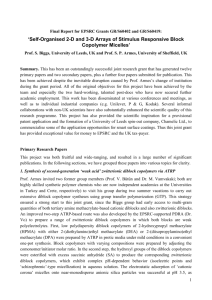Supplementary material Glycyrrhetinic acid
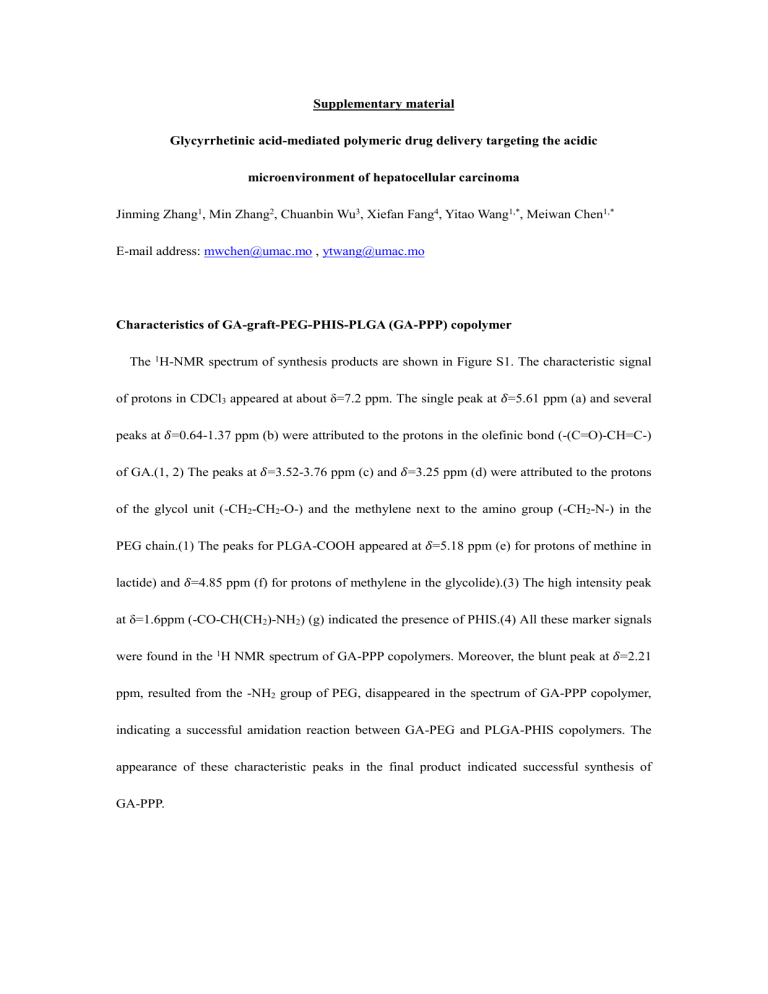
Supplementary material
Glycyrrhetinic acid-mediated polymeric drug delivery targeting the acidic microenvironment of hepatocellular carcinoma
Jinming Zhang 1 , Min Zhang 2 , Chuanbin Wu 3 , Xiefan Fang 4 , Yitao Wang 1,* , Meiwan Chen 1,*
E-mail address: mwchen@umac.mo
, ytwang@umac.mo
Characteristics of GA-graft-PEG-PHIS-PLGA (GA-PPP) copolymer
The 1 H-NMR spectrum of synthesis products are shown in Figure S1. The characteristic signal of protons in CDCl
3
appeared at about δ=7.2 ppm. The single peak at 𝛿 =5.61 ppm (a) and several peaks at 𝛿 =0.64-1.37 ppm (b) were attributed to the protons in the olefinic bond (-(C=O)-CH=C-)
𝛿 =3.52-3.76 ppm (c) and 𝛿 =3.25 ppm (d) were attributed to the protons of the glycol unit (-CH
2
-CH
2
-O-) and the methylene next to the amino group (-CH
2
-N-) in the
PEG chain.(1) The peaks for PLGA-COOH appeared at
𝛿 =5.18 ppm (e) for protons of methine in lactide) and 𝛿
=4.85 ppm (f) for protons of methylene in the glycolide).(3) The high intensity peak
at δ=1.6ppm (-CO-CH(CH
2
)-NH
2
) (g) indicated the presence of PHIS.(4) All these marker signals
were found in the 1 H NMR spectrum of GA-PPP copolymers. Moreover, the blunt peak at 𝛿 =2.21 ppm, resulted from the -NH
2
group of PEG, disappeared in the spectrum of GA-PPP copolymer, indicating a successful amidation reaction between GA-PEG and PLGA-PHIS copolymers. The appearance of these characteristic peaks in the final product indicated successful synthesis of
GA-PPP.
GA
NH2-PEG-NH2
GA-PEG-NH2
8 7 6 5 4 3 2
(A)
1 ppm
PLGA
PHIS
PLGA-PHIS
8 7 6 5 4 3 2 1
(B)
Figure S1 1 H NMR spectrum spectra of GA-PEG (A) and PHIS-PLGA (B)
The copolymers were further evaluated by FT-IR. The FT-IR spectra of GA-PEG, PLGA-PHIS, and GA-PEG-PHIS-PLGA are shown in Figure S2. Because functional groups such as hydroxy groups, carboxyl groups, and amino bonds in GA-PEG and PLGA-PHIS have strong absorption, shifts in the chemical groups can be discovered by FT-IR. For the GA-PEG and GA-PPP polymers, the wide band at around 3480 cm
−1
was attributed to the inter- and intra-molecular hydrogen
bonds of -OH in the PEG polymer as well as the stretching vibration of the three -OH in GA.(1)
The strong peaks at around 2880 cm
−1
and the narrow peak at 1112 cm
−1
were assigned to the
-CH
2
- and C-O groups in the PEG chain.(2, 5) In the PLGA-PHIS polymer, the bands at 2942 and
2851 cm -1
corresponded to the -C-H stretching vibration of PLGA,(6) and the bands for the C=O
bond stretching vibration of carboxyl group appeared at 1665 cm -1 . In the GA-PPP copolymer, the band at 1636 cm -1 belonged to the C=O bond stretching vibration of -CONH
2
group, and the band at 1618 cm -1 was related to the bending mode of N-H vibration. Again, these results indicate successful synthesis of GA-PPP.
GA
PEG-(NH
2
)2
GA-PEG-NH
2
3500
1760
1730
3000 2500 2000
Wavenumber(cm
1500
-1
)
1000
(A)
500
PLGA-COOH
PHIS
PLGA-PHIS-COOH
3500 3000 2500 2000 1500
Wavenumber(cm
-1
)
1530
1000 500
(B)
Figure S2 FT-IR spectra of GA-PEG (A) and PHIS-PLGA (B) copolymer
In vitro Cell Proliferation assay
The cytotoxicity of blank GA-PPP and PP micelles on different concentrations was determined using Hep3B cells.
Figure S3 In vitro cytotoxicity of the blank polymeric micelles against Hep3B cells for 24h.
The low cytotoxicity of AGP/GA-PPP micelles against normal liver L02 cells for 24h demonstrated that it possessed high safety for normal cells.
1 0 0
8 0
6 0
4 0
2 0
0
0
F re e A G P
A G P /P P
A G P /G A - P P P
5 1 0 1 5 2 0
A G P C o n c e n t r a t io n ( u M )
2 5
Figure S4 In vitro cytotoxicity of AGP/GA-PPP micelles against L02 cells for 24h.
Reference
1. Wu F, Xu T, Liu C, Chen C, Song X, Zheng Y, He G. Glycyrrhetinic acid-poly (ethylene glycol)-glycyrrhetinic acid tri-block conjugates based self-assembled micelles for hepatic targeted
delivery of poorly water soluble drug. The Scientific World Journal. 2013;2013.
2. Huang W, Wang W, Wang P, Tian Q, Zhang C, Wang C, Yuan Z, Liu M, Wan H, Tang H.
Glycyrrhetinic acid-modified poly (ethylene glycol)–b-poly (γ-benzyl l-glutamate) micelles for liver targeting therapy. Acta biomaterialia. 2010;6(10):3927-3935.
3. Wang JF, Yin C, Tang GP, Lin XF, Wu Q. Synthesis, characterization, and in vitro evaluation of two synergistic anticancer drug-containing hepatoma-targeting micelles formed from amphiphilic random copolymer. Biomater Sci-Uk. 2013;1(7):774-782.
4. Wu H, Zhu L, Torchilin VP. pH-sensitive poly (histidine)-PEG/DSPE-PEG co-polymer micelles for cytosolic drug delivery. Biomaterials. 2013;34(4):1213-1222.
5. He G, He Z, Zheng X, Li J, Liu C, Song X, Ouyang L, Wu F. Synthesis, characterization and in vitro evaluation of self-assembled poly (ethylene glycol)-glycyrrhetinic acid conjugates. Letters in
Organic Chemistry. 2012;9(3):202-210.
6. Stevanović M, Radulović A, Jordović B, Uskoković D. Poly (DL-lactide-co-glycolide) nanospheres for the sustained release of folic acid. Journal of Biomedical Nanotechnology. 2008;4(3):349-358.
